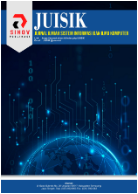Analisis dan Perancangan Sistem Informasi Hollowframe Berbasis Website Menggunakan Metode Waterfall untuk Meningkatkan Manajemen Data
DOI:
https://doi.org/10.55606/juisik.v5i1.1462Keywords:
Digital Product, Information System, Purchase Flow, Transaction Verification, User LoginAbstract
This study aims to analyze the workflow of a digital product purchasing system, focusing on the user login process, admin verification, and product access after payment. The system involves three key actors: the buyer, the system, and the admin, each playing a crucial role in ensuring the security and continuity of transactions. The workflow is designed to minimize transaction errors, ensure data validity, and improve operational efficiency and security in managing digital products. The study employs flowcharts and Unified Modeling Language (UML) diagrams to visually represent the interactions between these actors and the system. The analysis begins with the user login process, where the buyer provides authentication credentials, followed by admin verification to ensure authorized access. Once the payment is processed, the system verifies the transaction and grants the buyer access to the digital product. Each step is mapped using flowcharts to depict the sequential actions and decision points within the system, while UML diagrams provide a more detailed view of system architecture and interactions. The findings reveal that the system is designed to mitigate errors through structured validation and secure data handling, enhancing the overall purchasing experience. Additionally, the admin's role is critical in overseeing transaction approval and ensuring that digital products are accurately delivered. The study highlights the importance of system design in supporting smooth transactions, fostering user trust, and maintaining high levels of security. This analysis is valuable for improving the design and performance of digital product purchasing systems in various e-commerce settings.
References
Alenezi, M., & Akour, M. (2025). Ai-driven innovations in software engineering: a review of current practices and future directions. Applied Sciences, 15(3), 1344. Alzhrani, A. M. (2020). The use of management information system to help decision making in digital firms. International Journal of Business and Management Future, 4(1), 21-26. https://doi.org/10.3390/app15031344
Asmarajaya, I. K. A., Sanjaya, K. O., Putra, D. M. D. U., Mahendra, G. S., & Hasanah, F. N. U. (2021). Sistem Informasi Keuangan pada Perusahaan Kost Elit dengan Metode Waterfall. Jurnal Swabumi, 109. https://doi.org/10.31294/swabumi.v9i2.10970
Azis, N. (2022). Analisis Perancangan Sistem Informasi.
Bowo, F. A. (2023). Penguatan UMKM melalui pembayaran digital: Strategi digital marketing dalam era baru. Jurnal Studi Interdisipliner Perspektif, 22(2), 134-140.
Dewi, N. M. W. S., Wisna, N., & Asniar, A. (2024). IMPLEMENTASI APLIKASI PENCATATAN TRANSAKSI PENJUALAN UMKM. Jurnal Ilmiah Manajemen, Ekonomi, & Akuntansi (MEA), 8(2), 1156-1172. https://doi.org/10.31955/mea.v8i2.4150
Fauzan, F. S., & Danu, D. R. (2025). Analisis Kepuasan Pengguna Sistem Informasi Manajemen Perpustakaan Universitas Dian Nusantara Menggunakan SLiMS 9 Dengan Metode End User Computing. Jurnal Kecerdasan Buatan dan Teknologi Informasi, 4(1), 25-32. https://doi.org/10.69916/jkbti.v4i1.190
He, J., Peng, J., & Zeng, G. (2023). The spatiality of the creative digital economy: Local amenities to the spatial agglomeration of creative e-freelancers in China. Journal of the Knowledge Economy, 14(4), 4608-4629. https://doi.org/10.1007/s13132-022-01088-6
Heriyanto, Y., Qalban, A. A., & Mukaromah, I. A. (2022). Pengembangan metode login two factor authentication (2fa) untuk keamanan sistem informasi akademik. Journal of Innovation Information Technology and Application (JINITA), 4(2), 142-150. https://doi.org/10.35970/jinita.v4i2.1637
Ismail, D. A., Huda, B., Hilabi, S. S., & Priyatna, B. (2024). Penerapan Desain UI/UX Pada Sistem Penjualan Berbasis Web Dengan Metode Desain Thingking. Innovative: Journal Of Social Science Research, 4(2), 5737-5748.
Kar, A. K., He, W., Payton, F. C., Grover, V., Al-Busaidi, A. S., & Dwivedi, Y. K. (2025). How could quantum computing shape information systems research-An editorial perspective and future research directions. International Journal of Information Management, 80, 102776. https://doi.org/10.1016/j.ijinfomgt.2024.102776
Ndruru, A., & Sianturi, F. A. (2025). Perancangan Sistem Informasi UMKM untuk Mempermudah Penjualan. Jurnal Kolaborasi Sains dan Ilmu Terapan, 3(2), 30-34.
Noor, R. (2021). Analisis Usability Process Flow Aplikasi Freelance Omline Menggunakan Post Study System Usability Questionnairre (Studi Kasus Aplikasi Sampingan) (Doctoral dissertation, Institut Teknologi Sepuluh Nopember).
Putra, D. B., Hakim, M. A. M., & Nurdewanto, B. (2023). Implementasi Electronic-Know Your Customer pada aplikasi Fintech untuk meningkatkan keamanan akun user. Journal of Information System and Application Development, 1(2), 111-120. https://doi.org/10.26905/jisad.v1i2.11112
Sari, A. R., Al Husnawati, H., Suryono, J., Marzuki, M., & Mulyapradana, A. (2025). Metode Penelitian Kualitatif, Kuantitatif, Dan R&D. YPAD Penerbit.
Shaddiq, S. (2025). Resiliensi SDM dalam menghadapi ketidakpastian ekonomi global: Studi kasus sektor industri kreatif. Jurnal Ekonomi Kreatif, 6(1).
Shetty, S., Shetty, T., & Amale, R. (2014). QR-Code based Digital Wallet. International Journal of Advanced Research in Computer Science, 5(7).
System Usability Questionnairre (Studi Kasus Aplikasi Sampingan) (Doctoral dissertation, Institut Teknologi Sepuluh Nopember).
Wang, Y., Arora, C., Liu, X., Hoang, T., Malhotra, V., Cheng, B., & Grundy, J. (2025). Who uses personas in requirements engineering: The practitioners' perspective. Information and Software Technology, 178, 107609. https://doi.org/10.1016/j.infsof.2024.107609
Yuliati, T., & Handayani, T. (2021). Pendampingan penggunaan aplikasi digital qris sebagai alat pembayaran pada umkm. Communnity Development Journal, 2(3), 811-816. https://doi.org/10.31004/cdj.v2i3.2612
Downloads
Published
How to Cite
Issue
Section
License
Copyright (c) 2025 Jurnal ilmiah Sistem Informasi dan Ilmu Komputer

This work is licensed under a Creative Commons Attribution-ShareAlike 4.0 International License.










